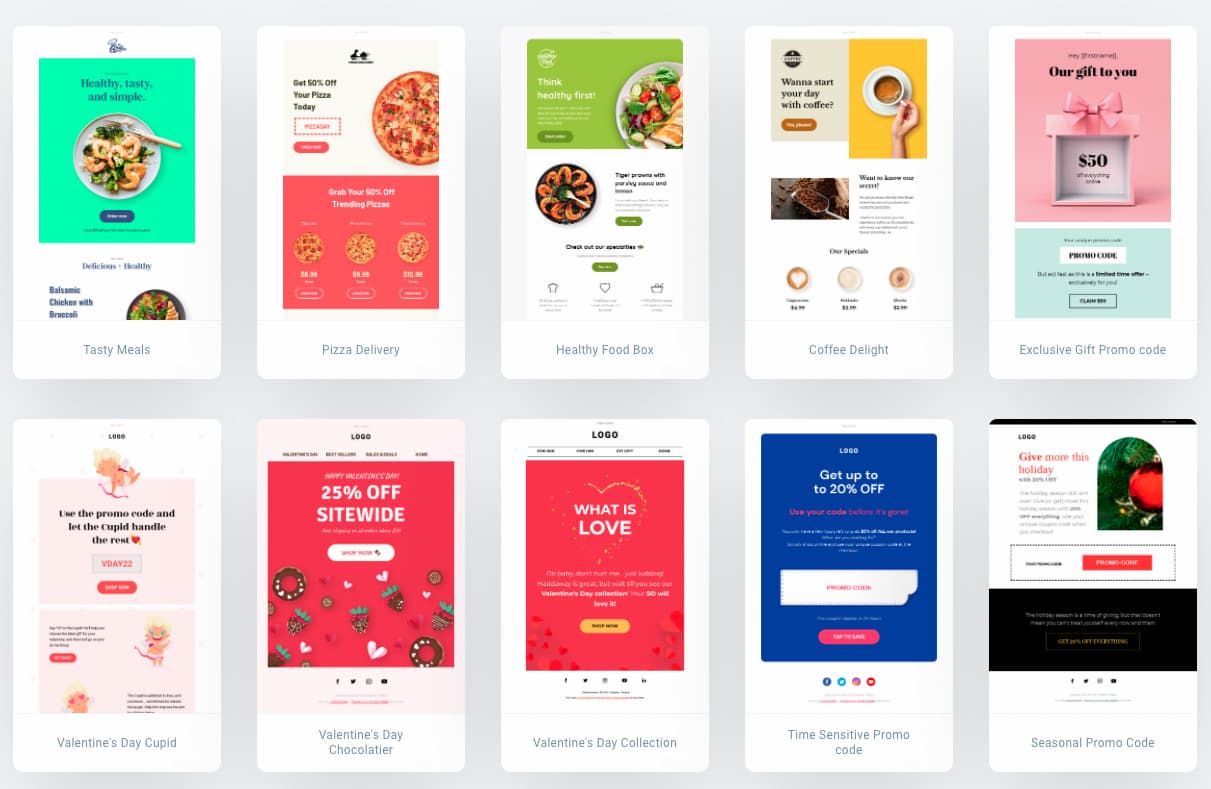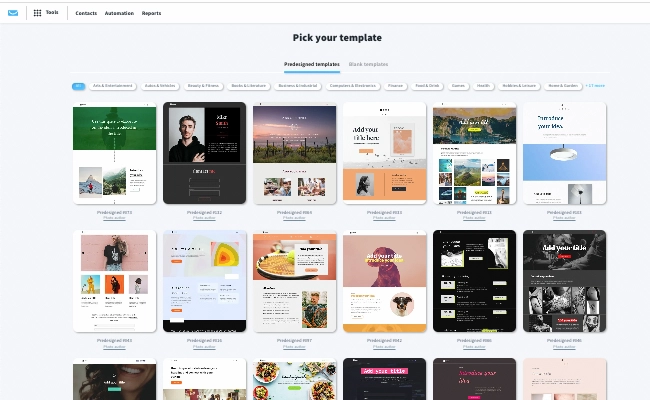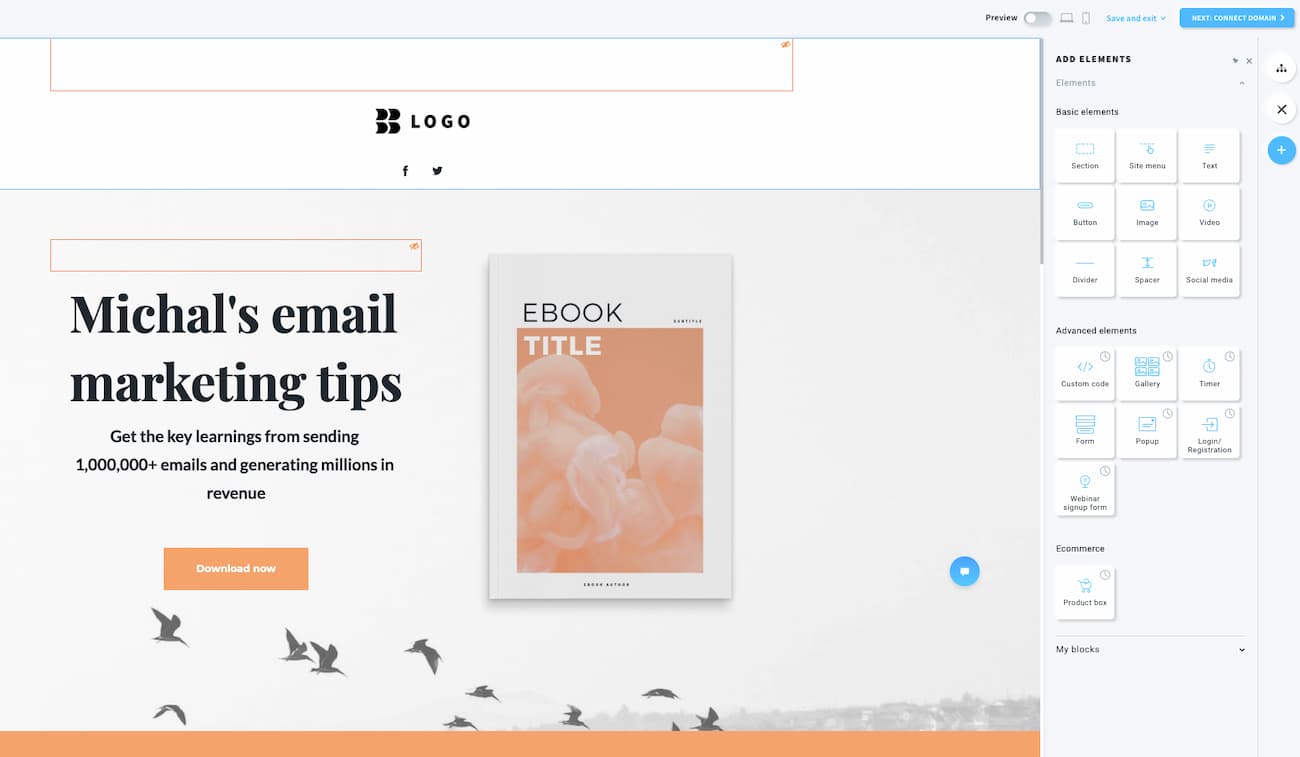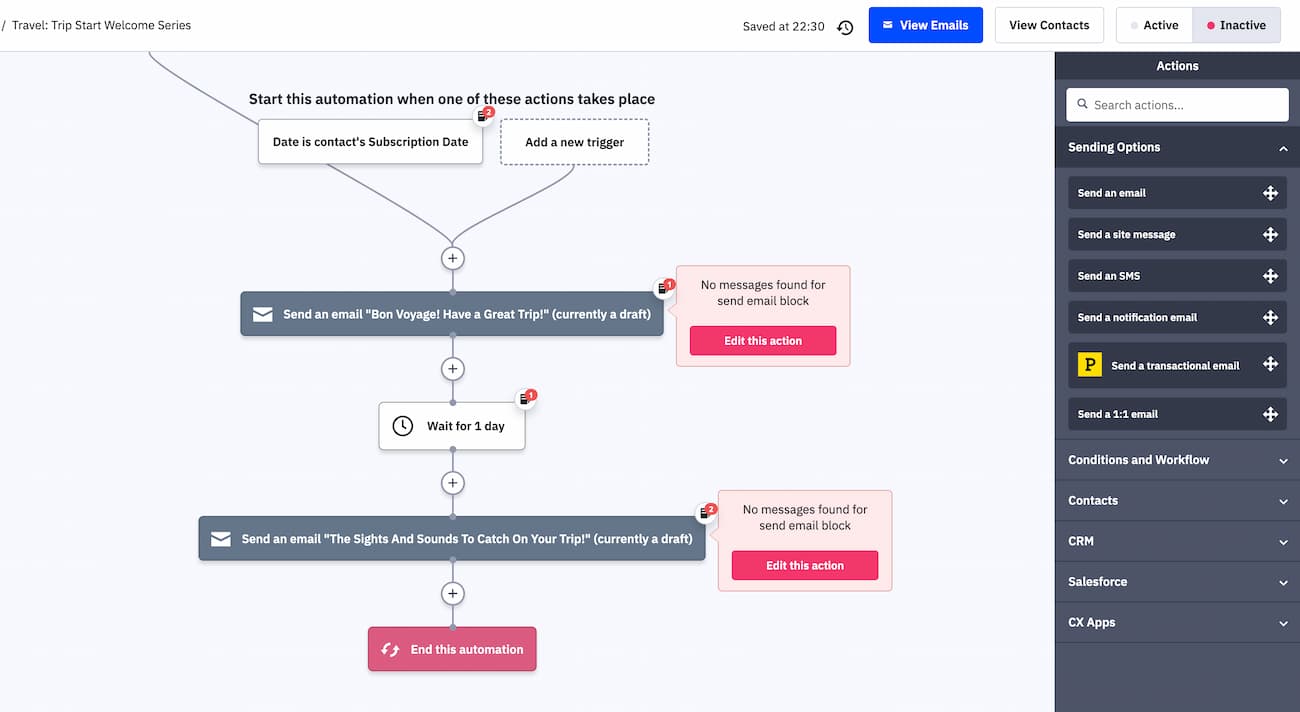Picking the right email and marketing automation software for your business is hard.
And if you’re reading this, it’s probably because you’re trying to make a tough decision right now about which tool is best between GetResponse and ActiveCampaign.
Of course, we’re a little biased since we built the former.
We think GetResponse is #1 because we built it with great email marketing capabilities, forms, web push notifications, SMS, and other inbuilt features.
But we want you to be the judge here. So in this post, we’ll compare ActiveCampaign and GetReponse’s features so you can choose which is best for your business.
To provide you with the best insights, we’ll be going over each key feature one by one. But if you’re in a hurry, here’s a quick table that sums up which features are included in each platform.
| Feature | GetResponse | ActiveCampaign |
|---|---|---|
| Email Marketing | Yes | Yes |
| Email Creator | Yes | Yes |
| Email Templates | Yes (100+) | Yes (100+) |
| Built-in Stock Photos | Yes (2m+) | No |
| Segmentation | Yes | Yes |
| Marketing Automation | Yes | Yes |
| Signup Forms | Yes | Yes |
| Webinars | Yes | No |
| Conversion Funnels | Yes | No |
| Facebook Ads | Yes | No (only through integration) |
| Google Ads | Yes | No |
| Web Push Notifications | Yes | No |
| SMS | Yes | Yes |
| Live Chats | Yes | Yes |
| 24/7 Support Access | Yes | No |
| Dashboard available in multiple languages | Yes | Yes |
| Phone Support | No | Yes |
| Integrations | Yes | Yes |
Want to see GetResponse in action? Sign up for a free account and test all our premium features for 30 days – completely free. No credit card needed.
1. Which one has better email marketing features?
GetResponse:

GetResponse email marketing is the bread and butter of our platform.
With GetResponse, you can attract new subscribers with signup forms and pop-ups, target your audience using advanced segmentation, and send beautiful email campaigns using prebuilt email templates and advanced drag-and-drop Email Creator.
Thanks to these tools, in minutes you can launch:
- Newsletters
- Autoresponders
- Email sequences
- Segmented campaigns
- Automated RSS feeds (blog posts)

If you have an existing contact list, you can easily import them in bulk using a CSV file or integrating with external services.
So, what makes it good for small or medium businesses?
Not only is it super easy to use (the drag-and-drop builder lets you quickly build a professional-looking email with your own copy and images in minutes), but it also nurtures leads and customers for you.

For instance, when an email lands in your contact’s inbox, GetResponse tracks how many times it gets opened and if the lead clicks any links. From there, you can see which contacts on your list are more engaged and likely to buy your products and run A/B testing to make future campaigns more successful.
It won’t take up much of your time, either. The “quick actions” menu makes it quick and easy to build professional email marketing campaigns, or if you need more input, the main navigation menu is equipped with all the tools you need to build a campaign that’ll grow your list:

The best part is that, unlike a lot of the other tools on the market, GetResponse comes fully equipped with other features like landing pages, conversion funnels, webinars, and chats which give your email campaigns a better shot at being successful.
ActiveCampaign:

ActiveCampaign’s email marketing suite also packs a punch.
You can use the software to build various types of email marketing campaigns, like triggered and targeted emails as well as autoresponders. It also has prebuilt email funnels, which are helpful if you need to set up a campaign quickly, or you are a newbie when it comes to email marketing.
Like GetResponse, ActiveCampaign also has a drag-and-drop tool, which makes it easier to build professional-looking email campaigns without any coding experience. There is also an extensive library of mobile-friendly templates you can use to start sending out successful email campaigns.
Verdict:
The biggest difference between the two platforms is the number of features each of them offers. GetResponse has a full-suite platform, but ActiveCampaign doesn’t have features like conversion funnels, webinars, and social media tools that make it easier to launch successful email marketing campaigns.
Want to try it for yourself? Create a free GetResponse account. No credit card needed.
2. Deliverability is a big issue, so which tool does it better?
GetResponse:
An email marketing tool is only useful if those emails actually land in your contacts’ inboxes.
At GetResponse, one of our bragging points is that the deliverability rate for our customers collectively sits at 99%!
So why and how is our deliverability rate number so high?
A lot of our success comes down to factors like message content and the trust we’ve built with Internet Service Providers (ISPs) around the world.
They trust us because we not only have a zero-tolerance policy towards SPAM, but we also make it easy to keep lists clean with our management tools and track undeliverable email addresses to make sure they’re filtered out.
We’ve also built an in-house in-house anti-abuse system called Hydra, that helps identify and assess potential threats posed to our customers’ reputation and deliverability.
Another thing that sets us apart is that we have two full-time Teams devoted to Email Deliverability & Compliance – and we’ve been in this business for over 20 years.
In other words, if you’re sending your emails with us, you’re in good hands.
ActiveCampaign:
ActiveCampaign also has a high deliverability rate for their emails.
It’s a well-established tool with years of experience on the market, transparent policies, and great technical support.
You’ll be in good hands if you choose to work with them.
Verdict:
Both of these tools are likely to get your emails to their destination.
3. Do they both offer landing pages?
GetResponse:
Yes — GetResponse has a tool where you can build custom pages or use over 180 different templates to create the perfect landing page.

Like the email drag-and-drop tool, GetResponse landing page builder is all about ease of use. You can create landing pages that are mobile-responsive and professional without any coding experience.
And if you want to add code? Using the editor, you can add custom code using HTML, CSS, or Javascript. If you want to add or embed any external elements, all you need to do is a quick cut and paste.
And to make the page pop, the tool has a built-in image editor that lets you add your own images. You can also import photos straight from Shutterstock or even add engaging GIFs from Giphy to your landing page.

Once you’re happy with how the landing page looks, you can launch it immediately and start collecting leads that’ll be filtered straight into your email lists.
With the landing page creator, you can:
- structure your landing pages using sections
- add content blocks for images, video, text, and buttons
- add static and pop-up forms
- add webinar registration forms
- add a sense of urgency with countdown timers
- collect payments thanks to PayPal integration
- add social sharing icons
- add custom-code elements using HTML, CSS, or Javascript
- preview your landing page to see what it looks like on a desktop or a mobile device
ActiveCampaign:
ActiveCampaign also recently launched an inbuilt landing page builder.
Like GetResponse, it has a drag-and-drop designer tool that was created with ease of use in mind. You can build professional looking landing pages with a couple of clicks:

There is also a library of templates you can choose from, and you can switch out parts of the template to add in your own images, videos, and calls to action.
Verdict:
Both tools offer great, value-for-money landing page builders.
4. What about conversion funnels?
GetResponse:
Conversion funnels can be daunting to build, but GetResponse has simplified this once complicated process.
The Conversion Funnel feature in GetResponse makes it super easy for you to build successful conversion funnels, even if you’ve never done it before. The funnels are pre-designed scenarios of how a typical conversion might look.
For example, if you’re trying to sell a course, the conversion path may look like this:

With the Conversion Funnel feature, every step of this conversion is automatically organized into steps you can visualize:

Not only can you see how successful each step of your conversion path is, but you can also track how profitable your efforts are. You can see how many leads enter your funnel, and ultimately, how many turned into paying customers.
Best of all? All the tools needed to build your conversion funnel are already part of GetResponse.
ActiveCampaign:
ActiveCampaign doesn’t offer conversion funnels at this time.
Verdict:
If you’re looking for a solution that combines multiple channels (email, landing pages, sales pages, Facebook ads, Facebook Pixel, etc.) in one simple dashboard, then GetResponse is the right pick.
5. You might need webinars, which one offers this feature?
GetResponse:
You can launch an interactive webinar right from the GetResponse dashboard.
The webinar software’s functionality lets you create webinars that have a custom webinar URL, sign-up forms, and inbuilt polls and surveys:

Because the webinars link back to GetResponse, every lead you collect will be automatically added to your email lists and nurtured. If you launch a webinar using GetResponse, you’ll have access to key features like:
- Design tools and interactive whiteboard
- Screen sharing/interactive chat room
- Recording (so you can remarket the webinar once it’s over)
- Q&A session
- Moderated chat
- Multiple hosts
However, what makes GetResponse’s webinar tool stand out is that it has a prebuilt promotion machine you can use to sell stuff from inside your webinars. The machine has features like:
- Predesigned registration pages
- Advanced subscription settings
- Payment gateways
Using these features, you can sell products, services, and courses directly from your webinars.
Want to learn more about this tool? Check out how the GetResponse Marketing Team uses its own software to run webinar marketing campaigns.
ActiveCampaign:
ActiveCampaign doesn’t have its own webinar tool. But you can integrate with tools like GoToWebinar, StealthSeminat, and WebinarNinja to host webinars straight from the software.
Verdict:
GetResponse comes with built-in webinar software that you don’t need to pay extra for. And if you’d like to use an external tool to run your webinar campaigns with, both platforms will integrate with them seamlessly.
6. Any provisions for Facebook or Google ads?
GetResponse:
GetResponse has a suite of tools that were created specifically to allow small businesses and freelancers to create successful Facebook and Google ads campaigns without taking up loads of time.
Let’s take a look at the Facebook ad tool first, which allows you to easily create and publish ads from the tool’s dashboard straight to social media.
First, you can build a list for the ad to target by picking from categories like website visitors, similar audiences, or existing contacts.

Then, create your banners using a third-party tool like Canva or AdCreative. Once you’re happy with how the ad looks, all that’s left to do is upload and submit it — and you are done.
We also recently launched a tool that lets you build Google Ads from the dashboard. All you need to do is add your Google Ads account, add content to your ad, create a target audience, and set your budget:

Easy!
ActiveCampaign:
You can’t launch Facebook or Google Ads from ActiveCampaign, but you can still sync your Facebook Ads account and add/remove contacts from Facebook Custom Audiences.
Verdict:
If you’re looking for simplicity in your paid ads campaigns, GetResponse has got you covered.
7. When it comes to segmentation, which tool does it better?
GetResponse:
We think our suite of lead generation tools makes it easy to nurture contacts and convert them into paying customers.
How? By using segmentation to create highly targeted, personalized emails that make contacts feel like you’re talking to them 1-to-1.
This all starts with our forms, which we created to collect the most useful data from contacts when they sign up through a newsletter or landing page.
Once they land on your contact list, you can then assign tags to them based on their behavior, and send out targeted emails to specific groups.
What sets GetResponse apart is that it automatically picks the most engaged contacts out of your list so you can target them.
We call this an Engagement Score. Using real-time data, GetResponse gives every contact on your list a score based on a 5-step scale:
- Not engaged (when somebody is not interested in the content you send them… at all)
- At-risk
- Neutral
- Engaged
- Highly engaged (when somebody loves the content you send and is actively opening emails and clicking the links)
The Engagement Score will then be shown on your contact list, so you can target your most engaged contacts and increase your chances of turning them into paying customers.
An example of contacts with varying engagement scores
ActiveCampaign:
ActiveCampaign has a comprehensive segmentation tool that allows you to capture and use contact data like names, actions, and geography to segment contacts.
Not only can you track this data, but you can also use it to segment your contacts. In ActiveCampaign, you can use segmentation to target your contacts based on their behavior, using data like if a contact has opened an email or clicked a link:

Verdict:
The biggest difference between the two platforms is how intuitive GetResponse’s segmentation is.
While both platforms let you segment your email list into categories like products purchased, website visits, or industry, GetResponse also breaks down the lists into how engaged contacts are (automatically).
And that can be powerful when you’re targeting contacts and trying to close deals.
8. Do they both offer email templates?
GetResponse:
We offer 100+ responsive email templates built specifically for the GetResponse New Email Creator & to be opened on any device.

Each template is high quality and professionally designed so you can send out campaigns to welcome, educate, promote, and sell without needing any coding skills. To make things even easier, the library is split into sections, from online marketing to ecommerce, travel, notifications, and many others.
Like a lot of other tools in our toolkit, our email templates are easy to customize using a drag-and-drop builder.
ActiveCampaign:
ActiveCampaign also offers a bunch of templates you can use to send to your subscribers.
Like GetResponse, all of ActiveCampaign’s templates are mobile-friendly and easy to customize using the drag-and-drop builder. However, the library is slightly smaller, and the aesthetics seem a bit outdated.

9. Marketing automation? Anyone?
GetResponse:
One of the best parts about a marketing suite is that automation features can put everyday tasks on autopilot.
GetResponse Marketing Automation builder is one of the most comprehensive tools available for marketers who want to create simple and advanced automation.
The drag-and-drop marketing automation builder lets you create visual workflows to see the automation and customize each step as you go. You can create automation events based on your contacts’ behavior and then trigger actions to take place based on selected conditions.
For example, if you want a certain email to only be sent if a contact clicks a link within an email, all you have to do is create that sequence and condition using the visual automation builder:
With the workflow, you can also add a “trigger” into the workflow for events like:
- new subscribers
- email opens
- clicks on links
- abandoned carts
- product purchases
- product upgrades
- URLs visited (i.e. pricing pages)
ActiveCampaign:
ActiveCampaign also has a visual automation builder that allows you to see & construct the stages in your automation sequence.
All you have to do is add in your chosen conditions and emails, and ActiveCampaign will send out the campaign you design:

It also comes with 500+ ready-made automation templates (or recipes as ActiveCampaign calls it), which will help you get up to speed with their tool fast.
Verdict:
Both platforms offer robust Marketing Automation tools that you can use to run both simple & complex communication sequences.
Read more:
10. Do they both offer an autoresponder feature?
GetResponse:
Like a lot of other features that come with GetResponse, autoresponders come packaged and ready to use out of the box.
Using the autoresponder, you can nurture and maintain relationships with contacts without spending all your time stuck in your inbox.
Here’s a quick breakdown of everything you can do with GetResponse’s Autoresponder:
How do I create an autoresponder? – GetResponse Help
You can also view the autoresponders in a simple and intuitive calendar view. So if you’re running a specific campaign or want autoresponders to be sent out on a specific day, all you have to do is add it to the calendar:
ActiveCampaign:
ActiveCampaign also has an autoresponder feature that you can activate when you’re creating a campaign or building a marketing sequence using the automation builder.
You can set autoresponders to be sent out to new subscribers or through drip campaigns depending on where they’re at in your marketing funnel.
Using the automation builder, you can also customize the triggers when the autoresponder will be sent to a contact, like delaying it for an hour or a day after they sign up to your list:

Another cool feature? ActiveCampaign also has a built-in SMS autoresponder, so you can nurture contacts outside of their inbox.
Verdict:
Both platforms let you create email drip campaigns using Autoresponders.
ActiveCampaign’s feature also lets you add SMS to the equation, which might be useful if you’re running an ecommerce business.
11. What about pricing?
GetResponse:
GetResponse has several different pricing plans: Free, Starter, Marketer, Creator, and a custom one – Max.

Pricing ultimately depends on your list size & the number of features you want to have access to.
For lists of up to 500 contacts, try the Free account. For 1,000 contacts, the Starter plan will cost you just over $15 per month. That will get you access to GetResponse’s email marketing suite, autoresponders, landing pages, one custom workflow, and other essential features.
The next tiered plan, Marketer, costs $48/month and gives you access to additional solutions like unlimited workflows and ecommerce automations.
Finally, there’s the Creator plan that webinars, courses, premium newsletters, and other content monetization features.
💡 With the discounts GetResponse offers, you can get 18% off an annual plan. Special pricing is available for registered non-profit organizations (up to 50% discount). Custom solutions are available for lists with more than 100,000 subscribers.
ActiveCampaign:
ActiveCampaign offers a free 14-day trial and three paid plans: Plus, Professional, and Enterprise.

The Plus plan costs $49 per month. It gives you access to their marketing automation, email marketing, inline forms, and a few other features.
And if you want to A/B test your automations and use predictive sending, then you’ll need to go for their Professional plan that costs $149/mo.
Verdict:
Both GetResponse and ActiveCampaign offer some unique features and integrations.
Out of the two, GetResponse is more affordable for the same list size. It also comes with additional built-in functionalities that essentially eliminate the need to sign up for external tools to run your webinars or create conversion funnels.
GetResponse vs ActiveCampaign full feature comparison
| Feature | GetResponse | ActiveCampaign |
|---|---|---|
| Email Marketing | Yes | Yes |
| Email Creator | Yes | Yes |
| Email Templates | Yes (100+) | Yes (100+) |
| Built-in Stock Photos | Yes (2m+) | No |
| Segmentation | Yes | Yes |
| Marketing Automation | Yes | Yes |
| Signup Forms | Yes | Yes |
| Webinars | Yes | No |
| Conversion Funnels | Yes | No |
| Facebook Ads | Yes | No (only through integration) |
| Google Ads | Yes | No |
| Web Push Notifications | Yes | No |
| SMS | Yes | Yes |
| Live Chats | Yes | Yes |
| 24/7 Support Access | Yes | No |
| Dashboard available in multiple languages | Yes | Yes |
| Phone Support | No | Yes |
| Integrations | Yes | Yes |
So, ActiveCampaign vs. GetResponse… which one is better?
The answer to this question comes down to what you really need the tool to do.
If you want a tool that goes beyond email marketing and allows you to build professional Facebook ads, create custom conversion funnels, and nurture customers automatically — GetResponse is your tool.
However, the easiest way to make a choice is to compare features and pricing. Picking a marketing automation tool is a big step — so make sure you do your homework and that the tool you pick ticks all the boxes on your list before you invest!
And if you’ve already made your mind – and want to take GetResponse for a spin, you can create a free account using the button below. No credit card needed 🙂
Author’s note: This comparison is accurate on May 31, 2023. We do our best to keep it as accurate as possible, and we check it on a regular basis, however, if you want to acquaint yourself with the offer of our competitors, you should check it at their official website or contact their representatives.
